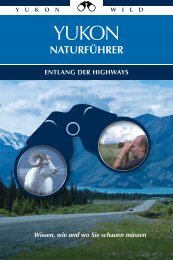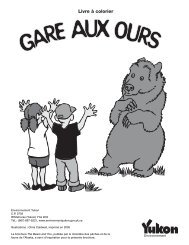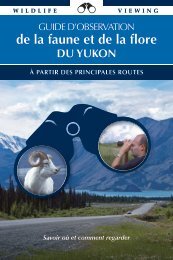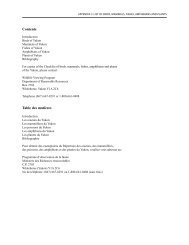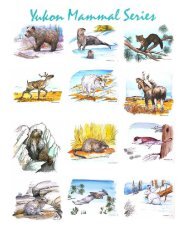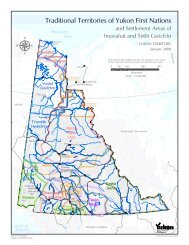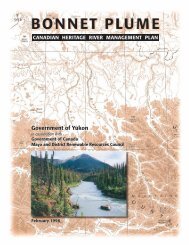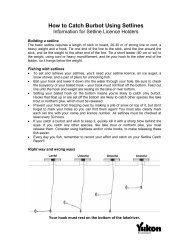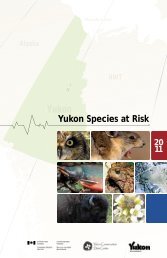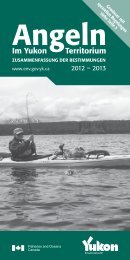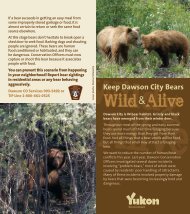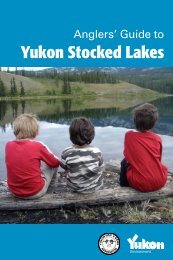Ch. 3 Land - Environment Yukon
Ch. 3 Land - Environment Yukon
Ch. 3 Land - Environment Yukon
You also want an ePaper? Increase the reach of your titles
YUMPU automatically turns print PDFs into web optimized ePapers that Google loves.
The <strong>Yukon</strong>’s beverage container<br />
recycling program<br />
Since the <strong>Yukon</strong> government first<br />
initiated a deposit-refund system on<br />
beverage containers in 1992, the<br />
Beverage Container Regulations have<br />
been expanded twice. In 1996 glass<br />
and plastic containers were added to<br />
the list; in 1998 tin and tetrapak<br />
containers were included.<br />
The deposit collected by retailers<br />
goes into a Recycling Fund, and is<br />
used to help run registered recycling<br />
centres. In 1997-98, 91.2 per cent<br />
of containers covered by the<br />
regulations were recouped based<br />
on sales of 16.4 million containers.<br />
Return rates in the Beverage<br />
Container Program peaked in 1997/98<br />
(Figure 3.17).<br />
Recycling Club<br />
The <strong>Yukon</strong> government started the<br />
Recycling Club in 1996 to promote<br />
the <strong>Yukon</strong>’s container recycling<br />
program. In 1998 more than 1,600<br />
<strong>Yukon</strong> youth joined the Club and<br />
earned more than 29 million Recycling<br />
Club points by turning in pop cans and<br />
other beverage containers. The points<br />
were traded in for prizes ranging from<br />
books to bicycles.<br />
This popular program, which is unique in<br />
North America, is credited with helping<br />
to increase container return rates from<br />
80 per cent to 91 per cent in 1997/98.<br />
Composting<br />
Many <strong>Yukon</strong>ers collect organic<br />
household waste in their backyards,<br />
using the rich compost to supplement<br />
their soils. Up to 50 per cent of<br />
household waste can be composted, so<br />
composting can also reduce the waste<br />
stream significantly. The City of<br />
Whitehorse runs two composting<br />
programs: Waste Watch and, through<br />
contracts, the Composting Program at<br />
the landfill.<br />
In the Waste Watch program, compost<br />
is collected every other week at the<br />
curbside. In addition to vegetable and<br />
table scraps, yard waste and other<br />
organic items, the Waste Watch<br />
program also accepts non-recyclable<br />
paper such as box board and paper<br />
napkins. These materials can be<br />
composted because of the high<br />
temperatures achieved in its large<br />
compost piles. The average<br />
temperature is 55°C.<br />
The Waste Watch program is the city’s<br />
main strategy for reducing residential<br />
garbage. It is estimated that Waste<br />
Watch can reduce the portion of<br />
residential garbage that the city hauls to<br />
the landfill by 40 per cent. This<br />
reduction would extend the life of the<br />
landfill by four years, saving $637,809<br />
over the next 30 years.<br />
The Recycle Organics Together Society<br />
(ROTS) began a community composting<br />
project in 1990, and in its first few<br />
years produced about 200 cubic<br />
metres of compost annually (Figure<br />
3.18). This immensely successful program<br />
now produces about 1,557<br />
tonnes of compost every year. The<br />
programme is currently operated by<br />
Raven Recycling under contract and is<br />
located at the landfill site. Raven Recy-<br />
Cubic metres of compost<br />
2000<br />
1500<br />
1000<br />
500<br />
0<br />
cling sells this valuable fertilizer to the<br />
public. This program has proven itself to<br />
be the most successful waste stream<br />
reduction activity so far.<br />
The value of compost was demonstrated<br />
in a pilot project, sponsored by<br />
the <strong>Yukon</strong> <strong>Ch</strong>amber of Mines, at the<br />
abandoned Whitehorse Copper Mine<br />
site. Different types of organic waste<br />
were rototilled into a series of test plots<br />
on the mine tailings. The site was<br />
irrigated for several seasons, but since<br />
1997 the vegetation has continued to<br />
grow on its own. This experiment<br />
showed a direct link between the<br />
amount of compost used and the<br />
amount of revegetation that took place<br />
on different plots.<br />
What are we doing about<br />
special wastes?<br />
The management of special waste has<br />
changed dramatically since 1995 when<br />
the Special Waste Regulations were<br />
enacted. The regulations state that<br />
special wastes must be disposed of in<br />
an approved manner. The change in<br />
disposal of waste oil is one example of<br />
the effect of the new regulations.<br />
1993 1994 1995 1996 1997 1998<br />
Figure 3.18 Organic material composted each year<br />
Of the 1500 cubic metres of organic material composted in 1998, an estimated 245<br />
cubic metres was collected from the 235 households on the Waste Watch programs.<br />
C H A P T E R 3 L A N D ❧ 5 7





